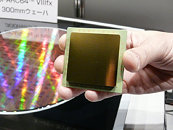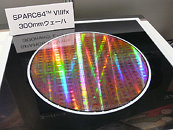Thursday, May 14th 2009

Fujitsu Develops the Fastest CPU in the World
10 years after they last held this title, Fujitsu have now snatched the status from previous record holder Intel, by developing a CPU (Central Processing Unit) capable of 128 billion calculations per second. Codenamed Venus, the chip is said to be able to calculate 2.5 times faster than the previous fastest CPU and using miniaturization technology, Fujitsu have managed to double the number of central circuits integrated onto a chip measuring about 2cm from four to eight. Venus is also said to consume only a third of the electricity compared to current levels.
Tens of thousands of these new chips are set to be used in a next-generation supercomputer for an Institute of Physical and Chemical Science which will go into operation at the end of fiscal 2010. It has also been said that should the Venus come to be used in devices such as personal computers and digital electronic appliances, it could lead to the development of equipment such as portable simultaneous interpretation devices and automated driving devices for cars.
Source:
Expreview
Tens of thousands of these new chips are set to be used in a next-generation supercomputer for an Institute of Physical and Chemical Science which will go into operation at the end of fiscal 2010. It has also been said that should the Venus come to be used in devices such as personal computers and digital electronic appliances, it could lead to the development of equipment such as portable simultaneous interpretation devices and automated driving devices for cars.


29 Comments on Fujitsu Develops the Fastest CPU in the World
"As of November 2008, only one of the world's top 500 fastest supercomputers is based on SPARC processors:
Rank #221: JAXA Japan, Fujitsu FX1, Quadcore SPARC64 VII 2.52 GHz, Infiniband DDR / 2008 Fujitsu , 20643 GFLOPS
This list compares unfavorably with other processor architectures, which make up a much larger portion of the top 500 list. The SPARC processor family had 88 of the top 500 systems in June 2002, but has since lost popularity to faster chips from IBM, Intel, and AMD."
So the "Crysis playing" CPUs are still top :P
Intel i7 = 50 GFLOPS = 50 billion calculations per second
So indeed about twice as fast
BUT
Larrabee = 2 TFLOPS = 2000 billion calculations per second = at least 10x new SPARC
larrabee >> new SPARC
Very. very interesting link from intel: http://www.intel.com/support/processors/sb/cs-023143.htm
OH, WAIT, Shame that Larrabee and the 4890 are both GPUs.
www.google.com/search?hl=en&safe=off&client=firefox-a&rls=org.mozilla%3Aen-GB%3Aofficial&hs=0pb&q=Intel+Larrabee&btnG=Search
See, most results have the word GPU or Graphics in it =/
:)
Senior Gigahertz is scheduled a 10 year term and will be promptly kicked out by Mrs. Tetra. Shes smoking hot!
en.wikipedia.org/wiki/X86
en.wikipedia.org/wiki/Larrabee_(GPU) :p
The chip is only a prototype and won't ship for at least a year. Also, it will be water cooled. Don't know if that 50gflops figure was stock or oc'd. Therefore it will probably run at 4ghz.
So, it's not exactly vaporware, but it's not bankable yet either. Guess we'll have to see where Intel, IBM and AMD are in a year. :cool:
1./ They need 8 cores to do 2.5x the performance Intel Quad/i7. Well, Intel's 8 cores is on 2 chips, rather than one, but cheaply available, a la 2x Nehalem-EP. The performance of SPARC over intel is therefore 1.25x on a comparable 8 core system. Something tells me that on a $ basis, Intel will come out cheaper
2./ SIMD parallel supercomputing workloads; well that is very very similar to Larrabee, so by the end of the year, Intel will be snapping at SPARC as well as CUDA.Ah, an honest opinion is welcome. But it is trumped by an educated opinion. And that is that we accept CUDA as a math/SIMD programming environment, not a "GPU" as you define. And Larrabee will be much more powerful/flexible than CUDA. So it will be "less" GPU than CUDA is. Background reading will reveal that Larrabee is actually CPU, and GPU functions are in software code, not hardware shaders. So Larrabee is actually CPU.
Don't let marketing and "leaks" fool you. Larrabee is as much supercomputing as it is GPU. But by targeting a consumer application (graphics) it will mean a superscalar CPU can be made at very accessible prices.
Expect Larrabee to kill off what is left of physx and potentially knock over both CUDA and clearspeed.
There are really only two advantages of Larrabee:
1) It is a superscaler design: Intel doesn't have to reinvent it every time they want to release a faster product, they just have to add more cores.
2) It uses a wildly successful instruction set: developers can program specifically for it with relative ease. It should see much better software support than CUDA/Stream which hardly any games use.
More intresting is 'barrier synchronization'. A technology they introduced with the SPARC VII that allows a four-core chip to look like a much faster single-core chip as far as compilers are concerned. Sweet!
Now that Oracle has commited to SPARC, the future looks bright.
Higher price doesnt matter when powerconsumtion vs performance is more important, due to cooling actually cost tons of money, and in fact, buying the right thing can make you save alot of money, and make the expensive buy really worth it.
Again, i dont know much about sparc, I dont think larabee gonna kick off straight away, but AMD can make GPGPU's like larabee ;) they got the x86 licence, and ati :)
I wonder when we will see a time when cpu only translate work for the gpu :P